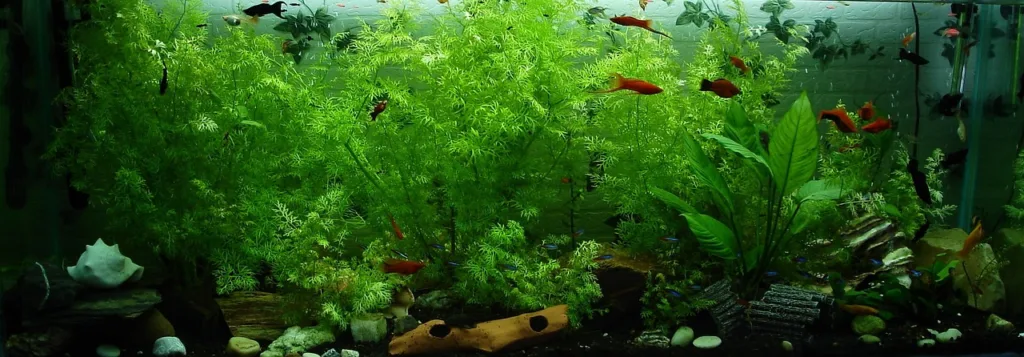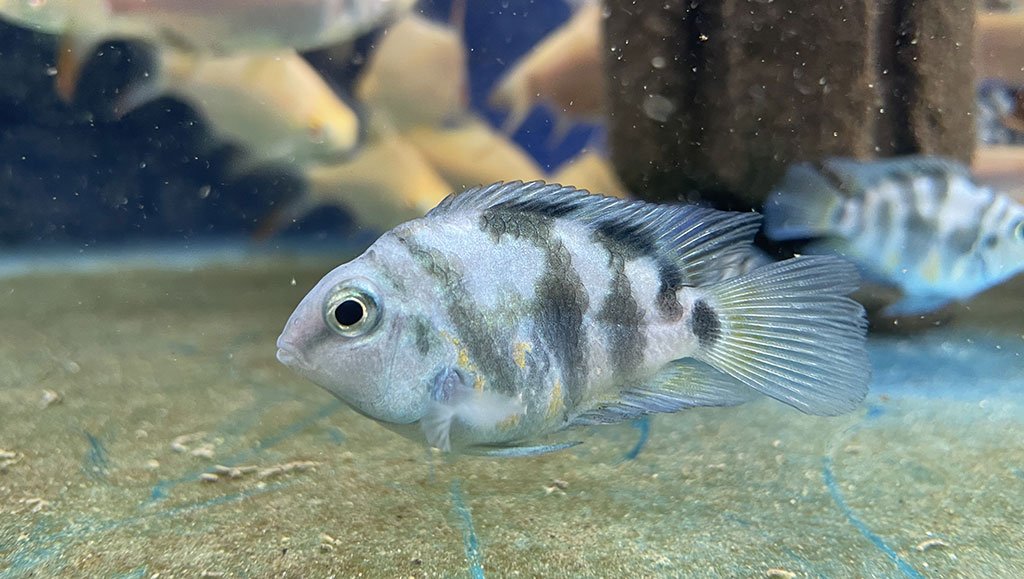Welcome to our guide on how to clean acrylic aquariums! If you’re like me and have a passion for the vibrant world of home aquariums, you know that the clarity of the tank is essential for showcasing its beauty. Acrylic aquariums are popular for their durability and lightweight nature; however, they require specific care to maintain their pristine condition.
Through years of maintaining my own aquatic haven, I’ve learned the do’s and don’ts of cleaning acrylic surfaces without causing any damage. In this article, I’ll share with you step-by-step instructions on effective cleaning techniques, the best tools for the job, and some personal tips to keep your acrylic aquarium crystal-clear. By the end of this guide, you’ll have all the knowledge you need to ensure your underwater world continues to thrive and dazzle anyone who lays eyes on it.
Key Takeaways
From my own experiences, here are the key points I’ve learned about keeping an acrylic aquarium clean and thriving:
- Be Gentle: Acrylic is susceptible to scratching, so always opt for soft, aquarium-safe cloths or sponges for cleaning. Hard scrubbing is a no-go.
- Choose the Right Tools: Invest in tools specifically designed for acrylic aquariums to prevent damage and ensure efficient cleaning.
- Monitor Water Parameters: After cleaning, testing the water for pH, ammonia, nitrite, and nitrate levels is critical to preserving the health of your aquatic environment.
- Proper Waste Disposal is Crucial: Safely disposing of cleaning waste protects not only your drains but also the environment from potential harm.
- Avoid Overcleaning: Striking the right balance is key. Overcleaning can harm the beneficial bacteria necessary for a healthy aquarium ecosystem.
- Seek Expert Advice: Don’t hesitate to reach out to manufacturers, join online forums, or engage with local aquarium clubs. The insights gained from experts and fellow enthusiasts are invaluable.
- Patience Pays Off: Regular, gentle cleaning routines reduce the need for deep cleans and keep your aquarium looking its best.
Understanding Acrylic Aquariums
In my years of aquarium keeping, transitioning from glass to acrylic tanks was a revelation. The experience taught me a lot, not just about the care that these beauties require, but also about their various advantages and unique properties. I’ll walk you through what makes acrylic aquariums stand out and how these factors influence our approach to cleaning.
Advantages of Acrylic Aquariums Over Glass
Firstly, acrylic aquariums are significantly lighter than their glass counterparts. This was a game-changer for me as it made the setup and relocation processes much easier, especially for large tanks. Additionally, acrylic offers superior clarity, providing an unobstructed view of the vibrant aquatic life within. Its ability to be molded into various shapes has also allowed me to experiment with unique designs, something that’s much harder to achieve with glass.
Unique Properties of Acrylic Material
Acrylic is known for its durability and flexibility, a contrast to the brittleness of glass. However, it’s not without its quirks. Acrylic is more prone to scratching, a fact I had to learn the hard way. This property greatly influences the cleaning methods and tools you can safely use on your acrylic tank, guiding you towards softer cleaning tools and gentler methods.
Factors Influencing Cleaning Methods for Acrylic Aquariums
Understanding that acrylic can scratch easily is pivotal in selecting the right cleaning tools and materials. Avoiding abrasive scrubbers and opting for microfiber cloths became part of my routine. Furthermore, the chemical sensitivity of acrylic means being selective about the cleaning solutions used, often opting for those specifically designed for acrylic.
Maximizing the Longevity of Acrylic Aquariums
To keep my acrylic aquarium looking its best, I also focused on preventing algae growth and maintaining water quality. Algae can be tougher to remove from acrylic without scratching, so prevention is critical. Regular water changes and careful monitoring of lighting have been key strategies in my approach.
Personal Tips for Maintaining Crystal-Clear Acrylic
Over the years, I’ve found that gentle, regular maintenance beats infrequent, heavy cleaning sessions. For instance, wiping down the interior with a suitable cleaning pad more frequently can prevent the build-up that requires harsher cleaning. Also, paying close attention to filtration helps maintain water clarity and reduces the need for manual cleaning.
Tools and Materials Needed for Cleaning
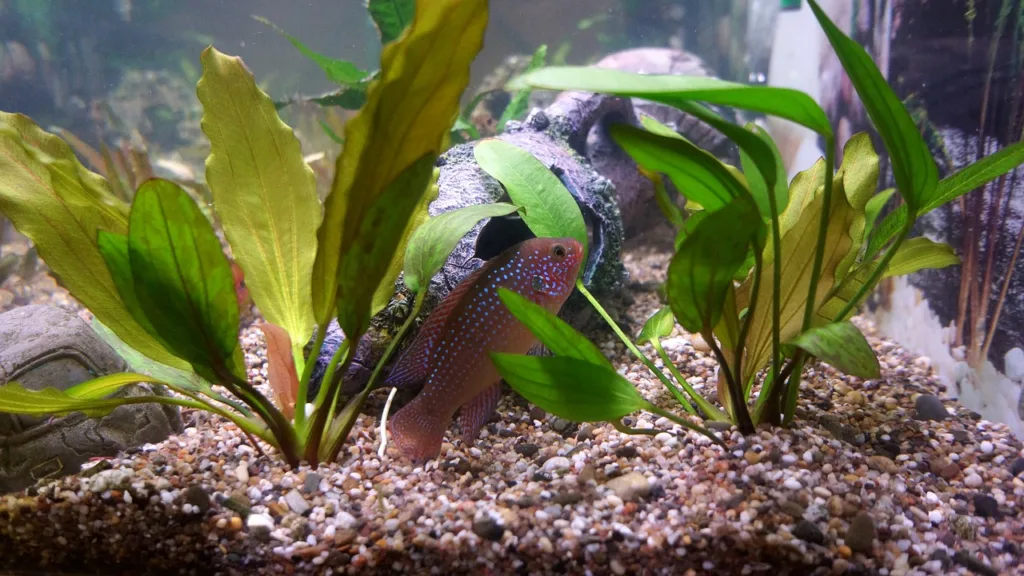
Now, let’s dig into the essential tools and materials you’ll need to keep your acrylic aquarium sparkling. Over the years, I’ve found a core set of items that are indispensable for the task. I’ll also share with you a couple of additional tools that, while not strictly necessary, have made my life easier and might do the same for you.
Non-abrasive Cleaning Supplies: Microfiber Cloth, Soft Sponge
The first on my list is always non-abrasive cleaning supplies. I cannot stress enough how a good quality microfiber cloth and a soft sponge have been game changers. The microfiber cloth, especially, is perfect for gentle daily wipes to remove fingerprints and small spots without scratching the surface. For areas with a bit more build-up, a soft sponge, used with a gentle touch, does the trick without leaving a single scratch.
Acrylic-safe Cleaning Products: Aquarium-safe Cleaners, Vinegar Solution
When it comes to cleaning products, not just any cleaner will do. I always reach for aquarium-safe cleaners specifically designed for acrylic. These ensure that I’m not introducing any harmful chemicals that could damage the acrylic or, worse, harm my aquatic friends. For a more natural approach, a vinegar solution (diluted with water) helps tackle water stains and build-up – just be sure to rinse thoroughly afterwards.
Equipment for Maintenance: Algae Scraper, Gravel Vacuum, and Filter Media
For regular maintenance, I have three go-to tools: an acrylic-safe algae scraper, a gravel vacuum, and spare filter media. The algae scraper is a must-have for managing algae growth without scratching. A gravel vacuum not only helps clean the substrate but also removes waste, preventing algae growth. And, always having spare filter media on-hand means I can swap out without waiting for a thorough clean and dry, ensuring my tank’s ecosystem stays balanced.
Lighting and Temperature Monitoring Tools: Thermometer, Light Timer
An often overlooked aspect of aquarium maintenance is monitoring the lighting and temperature. I’ve found that using a reliable thermometer to keep an eye on water temperature and a light timer to regulate the tank’s light exposure can prevent algae growth and promote the wellbeing of the tank’s inhabitants. These tools help maintain a stable environment, crucial for a thriving aquarium.
Water Testing Kit
Last but certainly not least, a comprehensive water testing kit is vital. Keeping tabs on water parameters like pH, ammonia, nitrites, and nitrates doesn’t just contribute to a clean-looking tank but, more importantly, to the health and safety of its residents. Regular testing allows me to act quickly if something is amiss, often preventing bigger problems down the line.
Step-by-Step Guide to Cleaning an Acrylic Aquarium
Cleaning an acrylic aquarium carefully and thoroughly is crucial to maintaining the health of your aquatic residents and the overall aesthetic appeal of your tank. Here’s a step-by-step guide based on my personal experiences, ensuring you do the job right without damaging your precious setup.
Draining and Removing Water from the Tank
The first step is to gently remove around 25-50% of the water from your acrylic aquarium. I always ensure to use a clean, aquarium-safe siphon for this process. This step is not just about removing water; it’s about carefully extracting waste and debris that settle at the bottom, which in turn helps in maintaining a healthy environment for your aquatic life.
Cleaning the Interior Surfaces: Removing Algae and Residue
Once the water level is lowered, cleaning the interior surfaces becomes much easier. Using an acrylic-safe algae scraper, I gently remove any algae clinging to the sides. For stubborn residue, a soft sponge dipped in a diluted vinegar solution has been my go-to. It’s effective yet gentle enough not to scratch the acrylic surface.
Cleaning Aquarium Decorations and Ornaments
Aquarium decorations and ornaments can accumulate algae and grime over time. I remove them from the tank and use a soft-bristled brush to clean them in a separate container filled with aquarium water I’ve drained off. This prevents the spread of harmful chemicals or germs that might be present in tap water.
Cleaning the Exterior Surfaces and Stand
Once the inside is dealt with, I don’t forget to clean the exterior of the aquarium and its stand. Using a microfiber cloth dampened with distilled water, I carefully wipe down the outside, removing fingerprints and dust. I make sure to be extra gentle around seams and edges to avoid water infiltration into the acrylic.
Replenishing Water and Re-introducing Fish
Before refilling the tank, I ensure the water is treated and at the right temperature, matching the tank’s conditions to prevent shocking my aquatic friends. After slowly filling the aquarium, I carefully reintroduce the fish back to their cleaned and refreshed home, monitoring them for any signs of stress.
Maintenance of Filtration System
I cannot overstate the importance of also cleaning the filtration system during your tank maintenance. Disassembling the filter and cleaning or replacing the media as instructed ensures that your system continues to function efficiently, providing a healthier environment for your tank inhabitants.
Final Checks and Balancing
My final step involves double-checking the tank’s overall condition, ensuring the decorations are properly placed, and the equipment is working correctly. I then test the water parameters to ensure they’re within safe ranges. Adjusting as necessary helps in avoiding any health issues for the fish post-cleaning.
Tips for Cleaning Acrylic Aquariums Safely
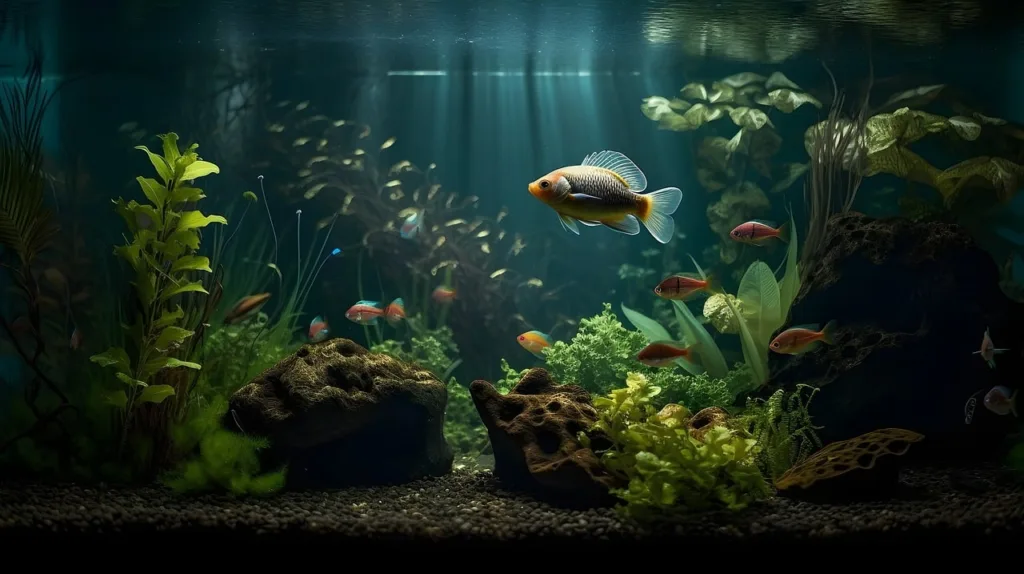
Maintaining an acrylic aquarium is essential for the health of its inhabitants and for the pleasure it brings you. However, it’s vital to approach cleaning with care to avoid damaging the delicate acrylic. Here are my personal tips and techniques for keeping your acrylic aquarium sparkling without causing harm:
Avoiding Abrasive Materials and Harsh Chemicals
In my experience, the golden rule for acrylic aquarium maintenance is to steer clear of abrasive materials and harsh chemicals. Abrasive sponges or cleaners can easily scratch the acrylic surface, and harsh chemicals might not only damage the acrylic but can also be harmful to the aquatic life inside. I always opt for soft cloths and aquarium-safe cleaners.
Using Gentle Cleaning Techniques to Prevent Scratching
Scratches are the bane of any acrylic aquarium enthusiast’s existence. To avoid these, I use gentle cleaning motions with soft sponges or microfiber cloths. It’s all about being gentle and patient, especially when addressing areas with more significant algae or mineral deposit buildup.
Testing Cleaning Products on Small Areas Before Full Application
Before I introduce a new cleaning product or method to my entire tank, I test it on a small, inconspicuous area. This precaution has saved my tank from potential damage numerous times. Only after ensuring that it doesn’t adversely affect the acrylic do I proceed to use it on the entire aquarium.
Regular Maintenance Schedule to Prevent Buildup of Algae and Debris
I’ve found that the most effective way to keep an acrylic aquarium clean is through regular maintenance. By sticking to a consistent cleaning schedule, I can prevent the buildup of algae and debris that would require harsher cleaning methods to remove later on. This not only keeps the tank looking great but also helps in maintaining a healthy environment for the aquarium inhabitants.
Careful Handling of Decor and Accessories
Whenever removing or repositioning decorations and accessories, I am extra cautious. These items can easily scratch the acrylic if not handled carefully. Always lift and lower decorations gently, avoiding dragging them across the tank’s surfaces.
Balanced Water Treatment and Handling
An aspect of aquarium maintenance often overlooked is the significance of proper water treatment. Ensuring that the new water is of the appropriate temperature and is treated to remove chlorine and other harmful chemicals is crucial for maintaining the integrity of the acrylic and the health of the tank’s ecosystem.
The Value of Patience
Lastly, patience is a virtue when it comes to maintaining an acrylic aquarium. Rushing through the cleaning process can lead to accidents and damage. Taking your time, being meticulous, and treating your aquarium with the care it deserves can make all the difference in preserving its beauty and ensuring the welfare of its inhabitants.
Troubleshooting Common Cleaning Issues
Over the years, I’ve encountered my fair share of cleaning challenges with acrylic aquariums. Here are some insights and solutions I’ve discovered for common issues, including a couple more you might find useful.
Dealing with Stubborn Algae Growth
Stubborn algae growth can be a real headache. In my experience, increasing the frequency of partial water changes and reducing the amount of light the aquarium receives each day can significantly control algae proliferation. For the algae that cling on, using a plastic razor blade on the acrylic surfaces has been effective for me. It’s gentle enough not to scratch but firm enough to remove tough algae.
Addressing Cloudy Water and Mineral Deposits
Cloudy water often results from overfeeding, lack of filtration, or bacterial blooms. I’ve found that improving the filtration system and adhering to a feeding schedule that doesn’t exceed what my fish can consume in a couple of minutes helps clear the water. For mineral deposits, a solution of white vinegar and water applied with a soft cloth has been my go-to fix; it removes the deposits without damaging the acrylic.
Preventing Scratches and Damage to Acrylic Surfaces
Preventing scratches requires a bit of diligence. I ensure that any cleaning tools are acrylic-safe and that any substrate I choose, like gravel, is smooth and rounded to reduce the risk of scratches when it inevitably gets pushed around. Likewise, I’m cautious when placing or moving decorations, opting for items that are less likely to cause damage if they’re accidentally knocked over.
Eliminating Odors from the Aquarium
At times, you might notice an unpleasant smell emanating from your aquarium. This usually points to decaying food, waste, or a dead fish hidden somewhere. Regular maintenance, including vacuuming the substrate and checking behind decorations, helps me keep odors at bay. Activated carbon in the filtration system can also absorb many of the smells before they spread.
Fixing Leaks in Acrylic Aquariums
Leaks can be alarming, but small leaks in an acrylic tank can often be fixed without having to empty the tank completely. I’ve had success using aquarium-safe silicone sealant. After lowering the water level below the leak, applying sealant and allowing it ample time to cure has saved my tank—and my floors—more than once.
Managing Temperature Fluctuations
Unexpected changes in water temperature can stress your fish and lead to health issues. I’ve found that installing a reliable aquarium heater with an external thermometer allows me to monitor and adjust the temperature as needed. It’s also wise to keep the aquarium away from windows and air conditioning vents to minimize sudden temperature changes.
Precautions and Safety Measures
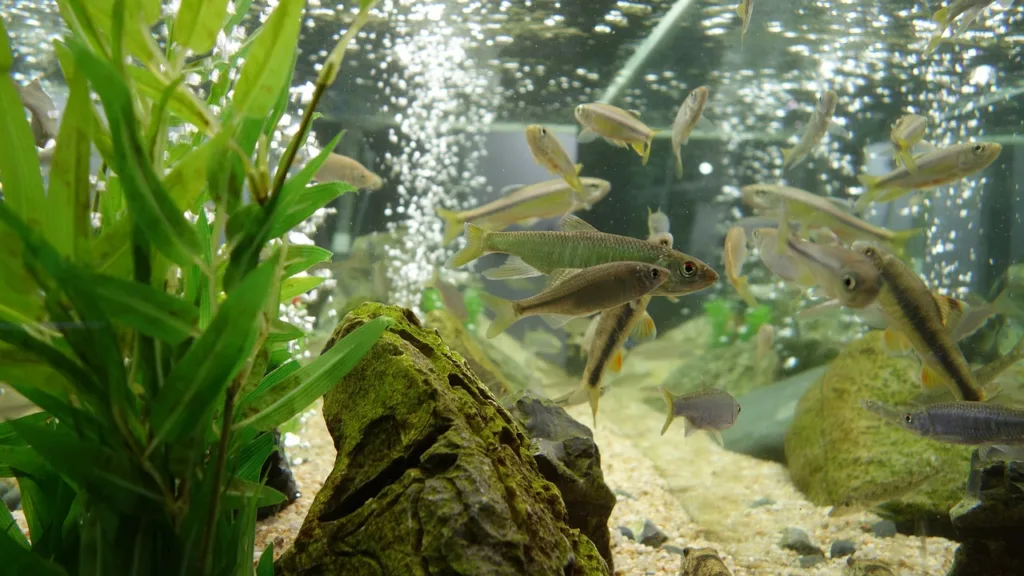
From years of tending to my underwater worlds, I’ve learned that maintaining an aquarium isn’t just about keeping it visually appealing; it’s immensely about doing so safely. Here are some precautions and safety measures I always adhere to, along with a few subtopics to explore.
Unplugging Electrical Equipment Before Cleaning
Before I dip my hands into the water, I ensure all electrical equipment, like filters and heaters, is unplugged. Not only does this protect me from potential electric shocks, but it also safeguards my aquatic friends from sudden changes or malfunctions with the equipment. It’s a simple step, but it’s vital for safety.
Handling Aquarium Cleaning Products with Care
Many cleaning products, although effective, can be harsh not only on the tank but also on your skin or when inhaled. I always wear gloves when handling these products and make sure the room is well-ventilated. It’s also crucial to double-check if a product is safe for use in an environment that houses fish and other aquatic life.
Monitoring Water Parameters After Cleaning to Ensure Fish Health
After every cleaning session, I diligently test the water for its pH, ammonia, nitrite, and nitrate levels. Even a slight deviation from their healthy ranges can cause stress or illness to the tank inhabitants. Ensuring the water parameters are balanced post-cleaning keeps everyone happy and healthy.
Ensuring Proper Disposal of Cleaning Waste
It’s easy to overlook the importance of properly disposing of the water and substances removed during cleaning. I make it a point to dispose of such waste safely, making sure it doesn’t harm the environment or clog my drains. Some materials, especially those from the filter, can be toxic if not handled properly.
Avoiding Overcleaning
In my early days, I was guilty of overcleaning my tanks, stripping them of the beneficial bacteria essential for a healthy ecosystem. I’ve learned that balance is key. A good clean should remove excess waste and algae without disturbing the tank’s biological balance.
Use of Appropriate Tools for Cleaning
Investing in the right tools for aquarium cleaning has been a game changer for me. I ensure that all my tools are specifically designed for aquarium use, minimizing the risk of introducing harmful substances or accidentally scratching the acrylic with inappropriate cleaning materials.
Consulting with Experts and Experienced Aquarists
In my aquatic adventures, connecting with experts and experienced aquarists has been instrumental in overcoming various challenges. Their insights have not only saved my tanks on multiple occasions but have also enriched my understanding and appreciation for the hobby. Here’s how I’ve benefited from their expertise:
Seeking Advice from Acrylic Aquarium Manufacturers
Initially, I was hesitant to reach out directly to manufacturers with my queries. However, I quickly learned that manufacturers are more than willing to offer advice on maintaining and repairing their products. Their tips on preventing scratches and dealing with algae growth specific to their acrylic aquariums have been invaluable. It’s like getting a manual customized to your particular situation.
Participating in Online Forums and Communities for Aquarium Enthusiasts
The camaraderie found in online forums and aquarium communities is incredible. Whether I’m facing an issue with water parameters or seeking inspiration for a new setup, there’s always someone ready to help or share their experiences. These platforms have also been fantastic for staying updated on the latest trends and innovations in the aquarium world.
Consulting with Professional Aquarists and Hobbyists for Personalized Recommendations
Personalized advice from professional aquarists and seasoned hobbyists has been a game-changer. Whether it’s through a local fish store visit or a scheduled consultation, these interactions have offered solutions tailored to my specific setup and the aquatic life I care for. The nuanced understanding these experts have of aquatic ecosystems is truly remarkable.
Attending Aquarium Workshops and Seminars
Whenever possible, I attend workshops and seminars led by aquascaping artists and marine biologists. These events have been instrumental in deepening my understanding of aquatic life. The hands-on sessions, coupled with Q&A opportunities, allow me to address my unique concerns while learning in a community setting.
Engaging in Local Aquarium Clubs
Joining a local aquarium club was one of the best decisions I’ve made. It’s provided a platform for face-to-face interaction with fellow enthusiasts and experts. The club meetings often feature discussions on topics like sustainable aquascaping and breeding practices, giving me insights I wouldn’t have found elsewhere.
My Opinion on Cleaning Acrylic Aquariums
From my personal experience, cleaning an acrylic aquarium efficiently and safely boils down to a blend of caution, the right tools, and a bit of patience. Remember, acrylic is more prone to scratching than glass, so always use soft, aquarium-safe cloths or sponges. I’ve found that regular, gentle cleaning prevents the buildup of algae and makes a deep clean less frequently necessary. My golden rule? Be gentle. Even when dealing with stubborn algae, resist the urge to scrub aggressively. If you’re using cleaning agents, ensure they’re safe for acrylic and, most importantly, for your aquatic friends. Lastly, engage with the community. I can’t tell you how many tricks and tips I’ve picked up from forums and fellow aquarists that have saved me time and prevented potential mistakes. Cleaning your acrylic aquarium doesn’t need to be daunting—it’s just another way to interact with and care for your underwater world.
